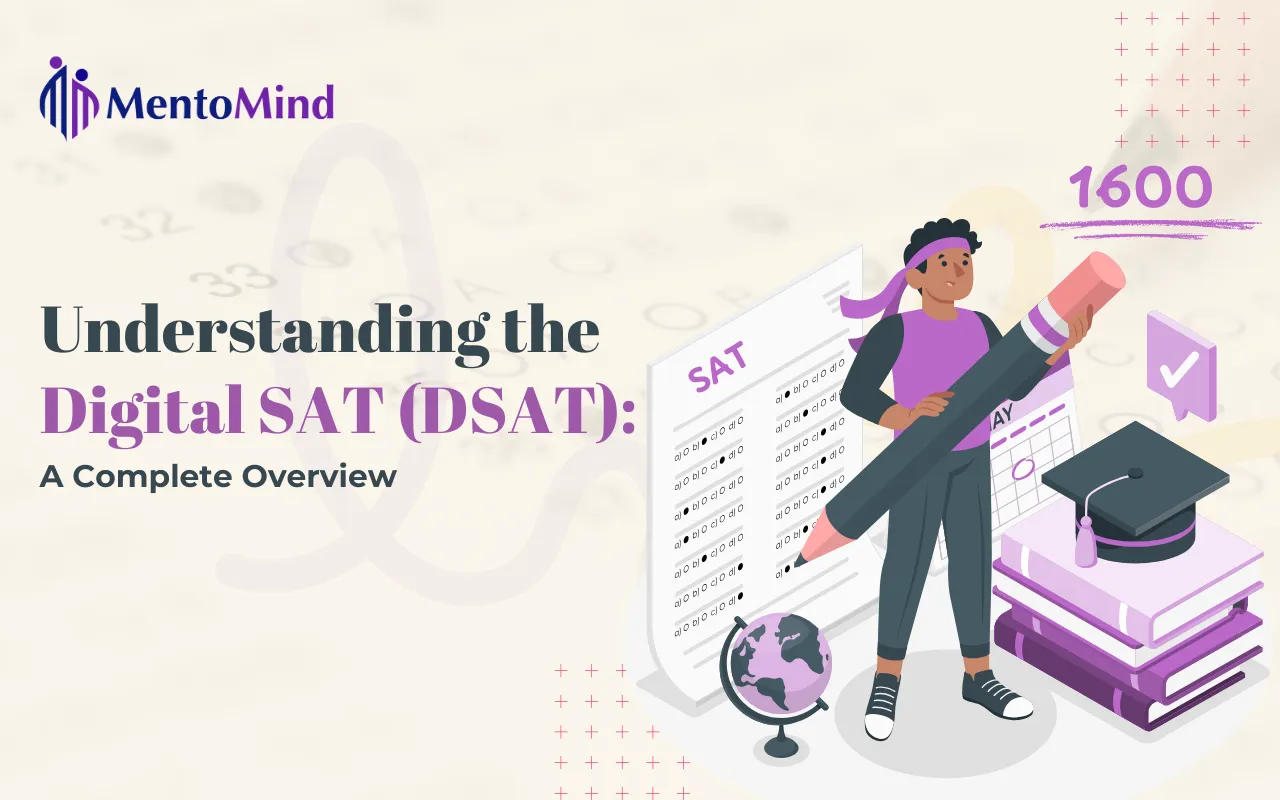What is the DSAT?
The Digital SAT, or DSAT, is the updated version of the SAT exam that is taken on a computer instead of paper. The College Board introduced this change to make the test more efficient, secure, and accessible for students. This shift aligns with technological advancements and allows for a more streamlined testing experience.
Key Changes in the DSAT
- Shorter Test Duration – The DSAT is now two hours and 14 minutes long, compared to the previous three-hour paper test version. This reduction in time makes the test less exhausting and more manageable. The test is now administered on the bluebook app.
- Adaptive Testing – The Digital SAT uses multistage adaptive testing, meaning the difficulty of later questions is adjusted based on a student’s earlier performance. Each subject (Reading & Writing and Math) is divided into two modules: all students start with a moderate first module, and their performance influences whether the second module is easier or more challenging.
- Digital Format – The DSAT is taken on a laptop or tablet using a specially designed testing app. This reduces issues related to paper booklets and answer sheets.
- Simplified Questions – Many questions have been updated to better assess skills without unnecessary complexity, making the test more straightforward and focused.
- Use of a Built-in Calculator – A graphing DESMOS calculator is available within the testing app for the entire math section. This allows students to focus on problem-solving rather than worrying about bringing a separate calculator.
- Faster Score Reports – Scores are typically available within two weeks, making the process much quicker. This enables students to plan their college applications more efficiently.
- Devices Allowed – Students can bring their own Windows or Mac laptops, iPads, or use school-managed Chromebooks. If a student doesn’t own a device, the College Board can provide one upon request.
- No “No-Calculator” Section – The earlier version had a section without calculators. The new DSAT allows calculator use for all math questions.
- Test-Taking Tools – The digital SAT provides tools such as a built-in timer, annotation tool, mark-for-review feature, and an option to adjust the divider between question and passage windows.
Structure of the DSAT
The DSAT consists of two main sections:
Reading & Writing: This section includes shorter passages with only one question per passage, making it more efficient than the traditional SAT format. The passages will include a variety of topics, including literature, science, history, and social studies.
Each module has 27 questions, out of which 25 are scored (operational) and 2 are unscored (pretest questions).
- Domains Covered: Vocabulary, Purpose, Dual Texts, Retrieval, Main Idea, Claims, and Conclusions for Reading; Vocabulary, Transitions, and Rhetorical Synthesis for Writing.
- Question Categories:
- Craft and Structure: ~28%
- Information and Ideas: ~26%
- Standard English Conventions: ~26%
- Expression of Ideas: ~20%
Math: Covers algebra, problem-solving, data analysis, geometry, and trigonometry, with an on-screen calculator available throughout. The focus is still on real-world applications and logical reasoning. For more information, read about our blog on the length of the sat.
Each math module contains 22 questions, 20 scored and 2 unscored
- Approximately 75% are multiple choice and 25% are Student-Produced Responses (entered via on-screen box, with support for decimals and fractions).
2. Domain Distribution:
- Algebra: ~35%
- Advanced Math: ~35%
- Problem-Solving and Data Analysis: ~15%
- Geometry and Trigonometry: ~15%
When do DSAT scores come out?
Superscoring on the Digital SAT
The Digital SAT supports superscoring, meaning colleges consider the highest section scores across multiple test attempts. If a student takes the SAT more than once, their best Reading & Writing and Math scores are combined to create the highest possible total score. Since many colleges accept superscores, retaking the SAT can be beneficial for improving overall results. Students should check individual college policies, as superscoring policies may vary.
Break Time on the Digital SAT
The Digital SAT includes one 10-minute break between the Reading & Writing section and the Math section. Since the test is shorter (about 2 hours, 14 minutes) than the traditional SAT, there are no other breaks. During this time, students can stretch, use the restroom, eat a snack, or refresh before continuing. It’s essential to manage your time wisely and return promptly, as the test resumes automatically when the break ends.
Accommodations on the Digital SAT
The Digital SAT offers accommodations like extended time, extra breaks, text-to-speech, screen magnification, and braille-compatible technology to support students with disabilities. Test-takers can also adjust font sizes and background colors for better readability. Accommodations must be approved in advance through the College Board’s SSD, ensuring a fair and accessible testing experience.
How to Prepare for the DSAT
- Practice with Digital Tools – Since the test is fully digital, practicing with online DSAT sample tests will help you get comfortable with the format. Familiarize yourself with the navigation tools and calculator. MentoMind has great SAT study tools to help you get your top score.
- Understand Adaptive Testing – Because the test adjusts to your performance, starting strong can lead to easier success in later sections. Take full-length practice tests to understand how the adaptive system works.
- Use the Provided Calculator – Make sure you’re familiar with the built-in calculator to save time during the exam. It is helpful to practice different types of problems using this tool.
- Read Shorter Passages Quickly – Since reading passages are now shorter, practicing quick comprehension will be beneficial. Focus on identifying key points and main ideas efficiently.
- Manage Your Time – Although the test is shorter, good time management is key to completing all questions efficiently. Take timed practice tests to improve your pacing.
- Stay Calm and Focused – While the DSAT is different from the traditional SAT, it’s important to stay calm and adaptable. Ensure you get enough rest before the test day and approach each section with confidence.
- Practice Environment Matters – Use College Board’s Bluebook App to simulate the exact test interface and tools like marking for review, annotation, and answer navigation.
Final Thoughts
The transition to the DSAT brings many benefits, including a shorter test, a built-in calculator, and quicker results. Understanding the new format and preparing accordingly will help you perform your best. Make sure to take advantage of online practice resources like MentoMind to get comfortable with the digital interface.
Additionally, colleges and universities are adjusting to the DSAT format, so it’s important to stay updated on their admission requirements. Be proactive in seeking guidance from teachers and counselors to ensure you meet all necessary criteria.
Are you ready to tackle the DSAT? Start preparing today and take the test with confidence!



